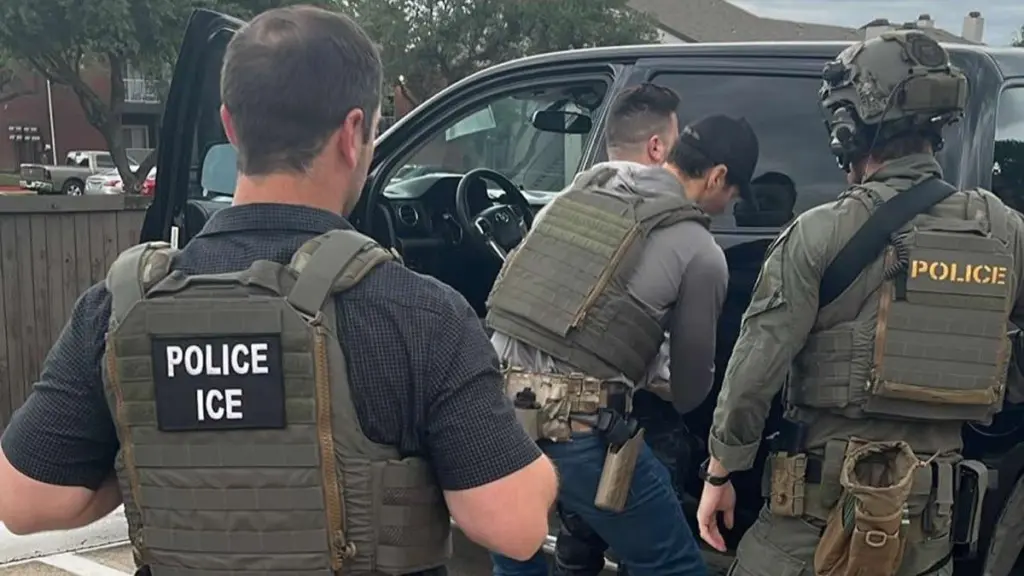BOISE, ID – Immigration arrests and detentions in Idaho sharply increased in 2025, following trends across the U.S.
Immigration and Customs Enforcement arrests in Idaho increased 797% in 2025 from the same time period in 2024, according to an Idaho Capital Sun review of ICE data collected by the Deportation Data Project. The project is led by attorneys and professors from multiple states who obtain public data sets through Freedom of Information Act requests.
From Jan. 1, 2024, to June 26, 2024, there were 41 reported arrests by ICE agents in Idaho, the data shows. For that time period in 2025, there were 368 arrests.
Idaho in 2024 and part of 2025 had certified the Elmore County and Jefferson County jails as federal immigration detention centers. From Jan. 1, 2024, to June 26, 2024, there were 65 reported ICE detentions in both of those facilities. For that period in 2025, there were 416 detentions, which is a 540% increase.
The number of detentions in the first six months of 2025 was more than double the number of detentions recorded for all of 2024.
“We’ve seen an increased number of calls, typically from loved ones whose loved one has been detained,” said Chris Christensen, a Boise immigration attorney. “We have seen a lot more immigration holds … and we’ve also seen a lot more aggressive tactics used by local ICE.”
Christensen, who has worked in various areas of immigration law since 2009, said he was aware of three recent incidents where ICE agents broke the window of a vehicle to remove someone inside.
The ages of those detained in Idaho ranged from 18 to 64 years old.
Definitions of common immigration terms
ICE arrest: Immigration officials locate and apprehend someone they suspect is in the U.S. illegally. These do not always lead to detentions.
Detention: Some people arrested by ICE agents are detained in facilities such as a county jail or federal detention center.
Immigration hold: ICE may be notified if an inmate in a local jail or prison is likely in the country illegally and will ask the local law enforcement to hold the inmate beyond their release date and transfer custody to immigration authorities.
The youngest people arrested in Idaho were a 6-year-old girl and an 11-year-old boy, both from Peru. The two children were arrested at the same time as a 33-year-old woman on Jan. 28 in the Twin Falls area. There is no record showing the woman and children were detained.
Christensen said in a February meeting with ICE agents in Idaho, local immigration lawyers were told that the agency tries to avoid detaining minors because there is nowhere to hold them in Idaho. Many of those arrested in southern Idaho end up going to a detention facility in Las Vegas, Christensen said.
The share of those arrested who had criminal convictions declined in 2025 from the year prior.
Of the arrests made this year, 250, or nearly 68%, of all arrests, were of people with criminal convictions. There were 84 arrests of those with “pending charges,” and 34 people with “other immigration violations,” according to the data.
In 2024, 34 of the 41 arrests were of those with a criminal conviction, or 82%, and five were of those with pending charges.
ICE arrests are up across the U.S., many without prior criminal convictions
Nationwide, the share of immigrants with criminal convictions has declined overall since January, Stateline reported. From January to late-June, ICE has made nearly 112,000 arrests, and 40% of them were of convicted criminals, the outlet reported. For the same time period in 2024, 53% of the approximately 51,000 arrests were of those with criminal convictions.
Arrests in Washington state rose 35% in the first five months of Donald Trump’s presidency, the Washington State Standard reported, with 782 arrests in 2025 compared to 581 the same period last year.
Trump administration officials have stated a goal of 3,000 immigration arrests per day; the current average is 711 as of June, the Stateline analysis of data found.
For those who have been in the U.S. for less than two years, officials under the current administration are using a process called expedited removal, Christensen said, which means they may be deported without the opportunity to see an immigration judge.
As of July, ICE issued a new policy that required those arrested by the agency to remain in detention while challenging their removal, NPR reported. The policy was challenged in court Monday in a class action lawsuit.
Christensen said this policy reverses a longtime interpretation of the law that allowed those who were considered a low or no threat to the community and a low flight risk to bond out of detention while their case went on in court.
“Personally, I think it’s the Trump administration using detention to wear immigrants down,” Christensen said. “If you’ve never been in jail before, and you are locked up in an ICE detention facility — which don’t get me wrong, looks exactly like a jail and feels exactly like a jail — people are pretty inclined to give up hope, and maybe give up on their case and return to where they’re from.”
Idaho’s law requires cooperation with immigration authorities
Through a law passed this year and an executive order by Idaho Gov. Brad Little, the state’s regulations largely require cooperation with immigration authorities.
On Feb. 18, Little issued an order requiring Idaho State Police and all state agencies to collaborate fully with federal immigration authorities. The order also directed the state’s prison and parole systems to confirm immigration status prior to releasing incarcerated individuals.
The Idaho Legislature this year also passed House Bill 83, which created new state-level immigration crimes and required cooperation among local authorities and federal agencies for enforcement.
The ACLU of Idaho challenged the law in court, arguing it superseded the federal government’s authority to enforce federal crimes, the Sun reported.
A federal judge temporarily blocked the portion of the law that would’ve created state crimes for illegal entry and illegal re-entry, but District Judge Amanda Brailsford did allow the parts of the bill requiring cooperation to go into effect.
In June, Idaho State Police announced it would enter into an agreement with ICE to assist with transporting undocumented immigrants from Idaho jails to ICE detention facilities. Under the agreement, the state police agreed to spend up to $300,000 for 100 transports, the Sun reported.
Little supported the effort by utilizing his office’s Emergency Fund to reimburse state police for personnel.
“Idaho is stepping up to help the Trump administration transport dangerous illegal alien criminals to ICE facilities instead of being released back into our communities,” Little said in a written statement June 5.
There have been no transports under this agreement as of June 30, an ISP spokesperson told the Sun.
What can be done after an ICE arrest or detention?
The options available to someone who’s been arrested by ICE are different in every case, Christensen said.
“I think (immigration law) is the most complex body of law out there,” he said.
The factors at play include a prior criminal history, community ties, the person’s “flight risk,” and others, he said. For those afraid to return to their country of origin, they could apply for asylum or protection under the international human rights treaty, the Convention Against Torture. Some may qualify for protection under the Violence Against Women Act.
Christensen said he’s also been receiving calls from people who are in the country lawfully, but who fear that may be revoked. His office has additionally seen an increased scrutiny and slower processing of green card applications.
“I think there is an assault on immigration at all levels,” Christensen said.
This story first appeared on Idaho Capital Sun.





